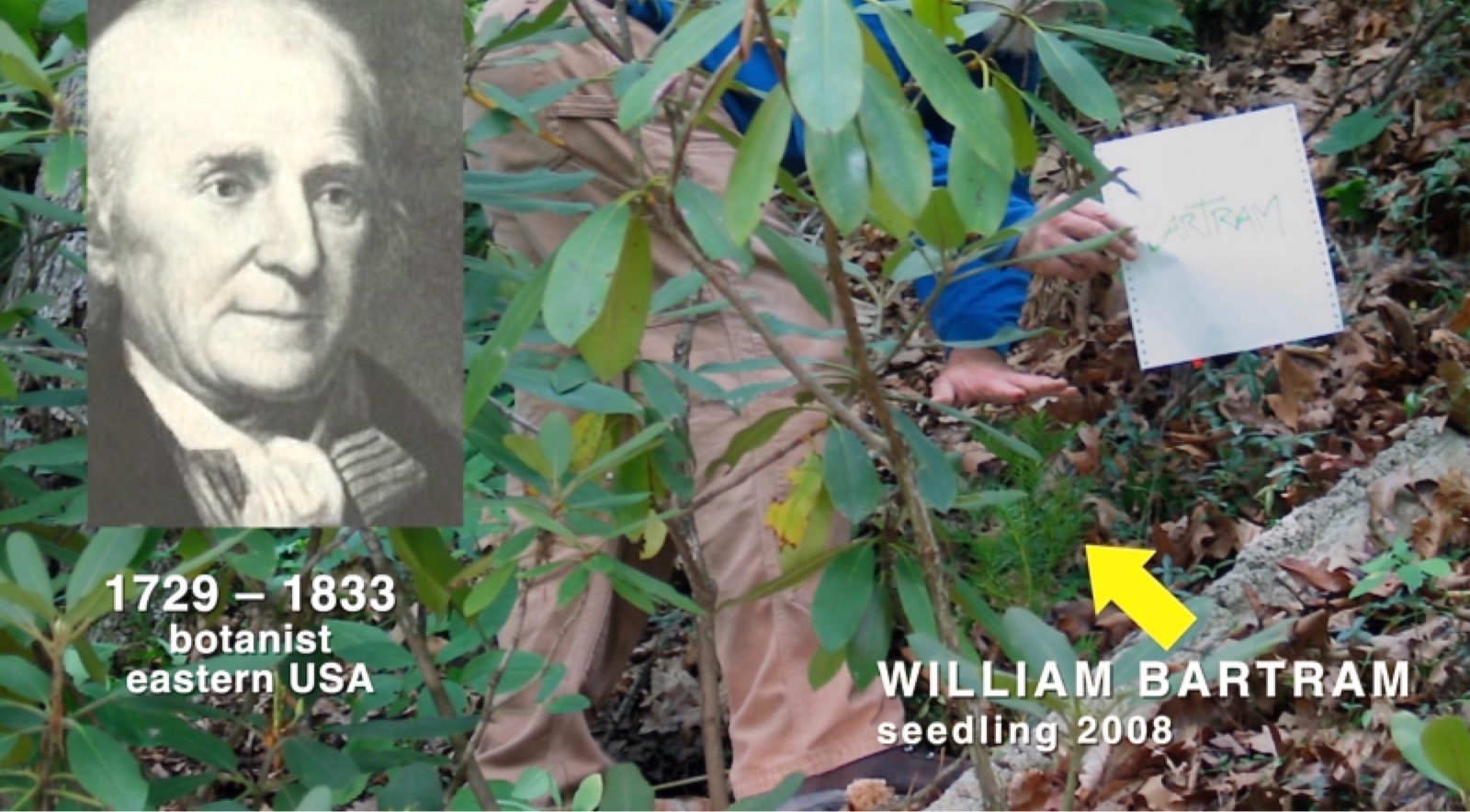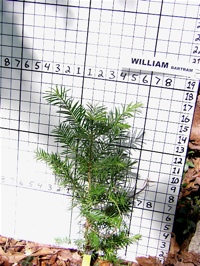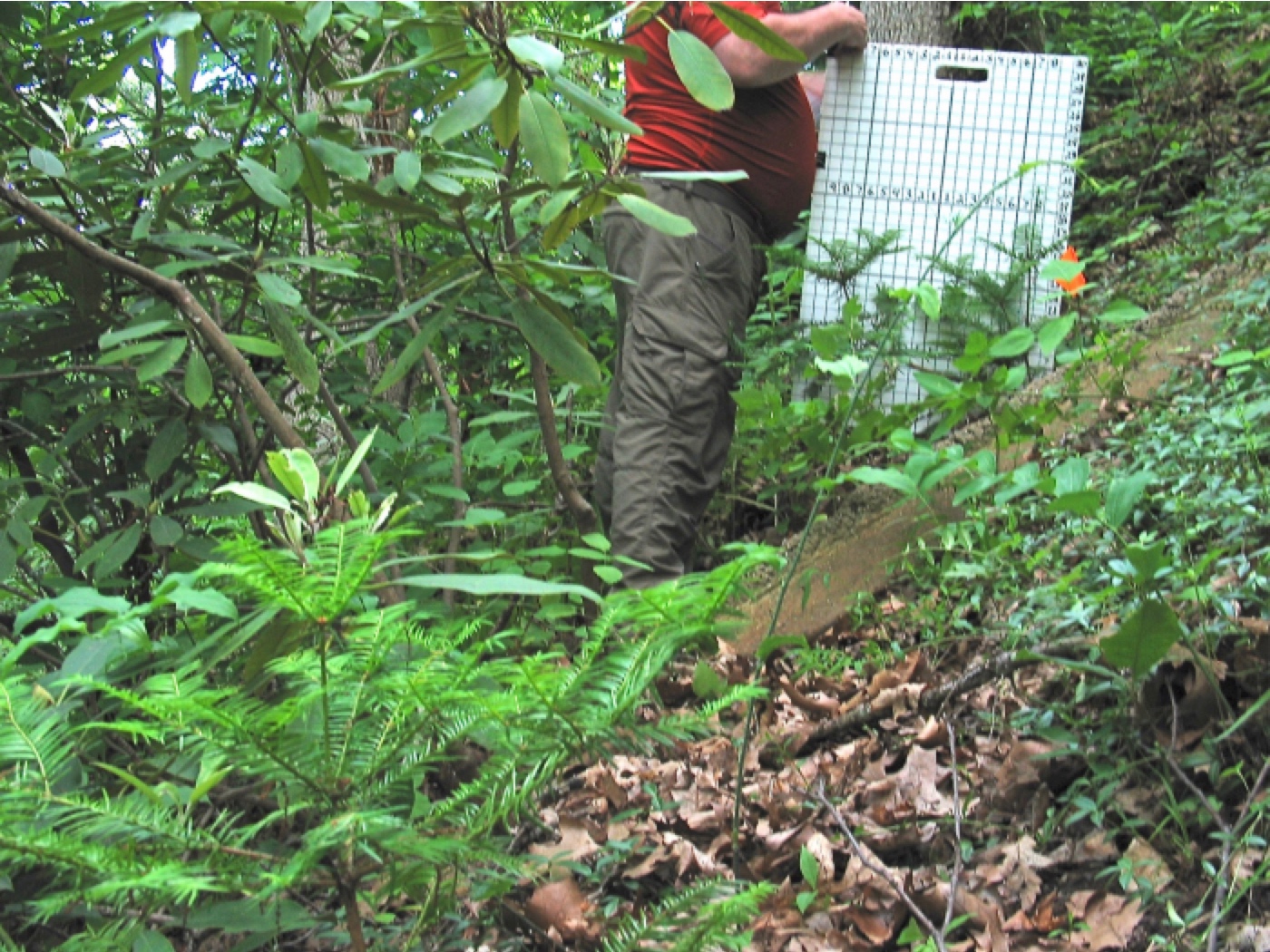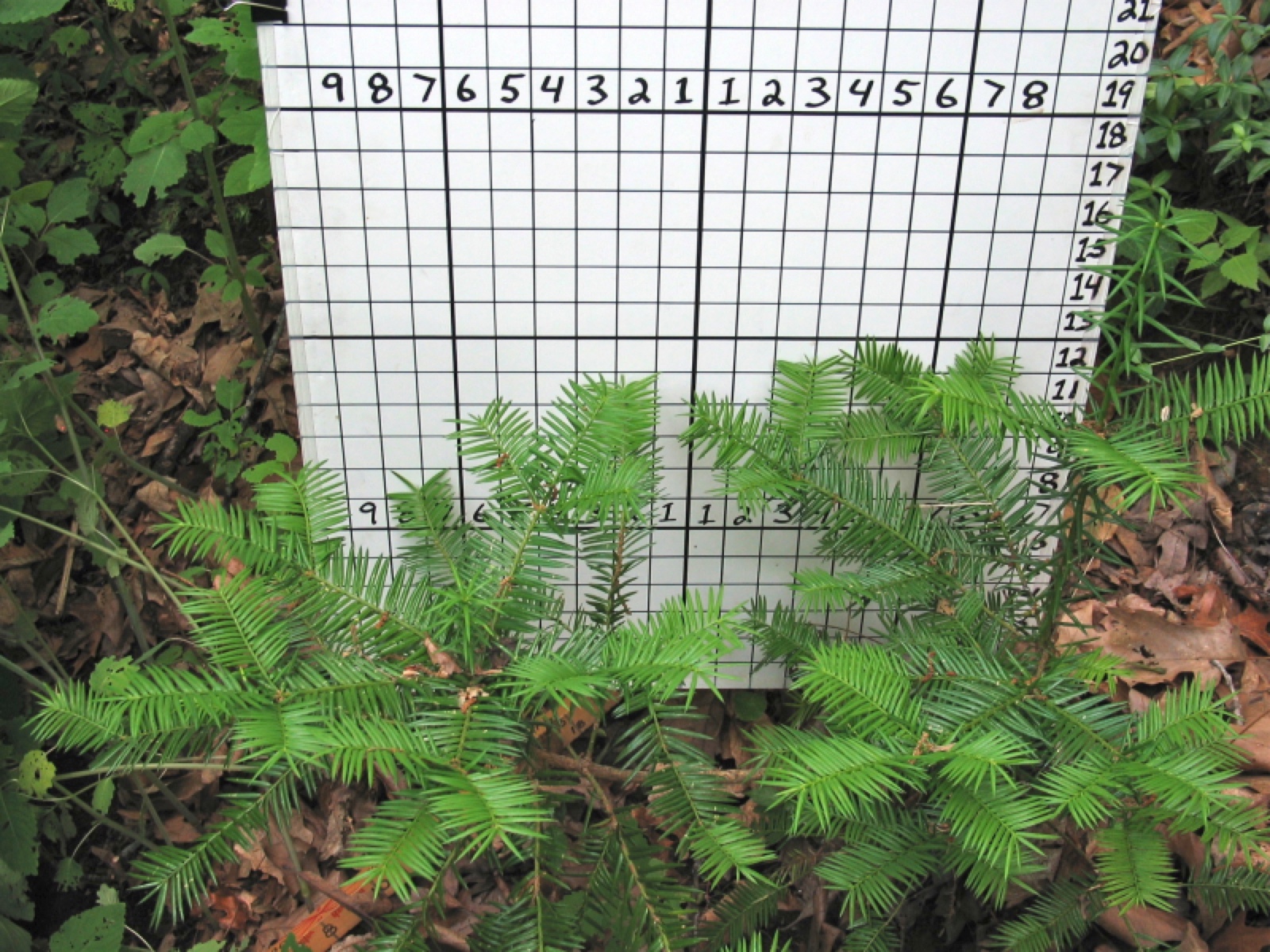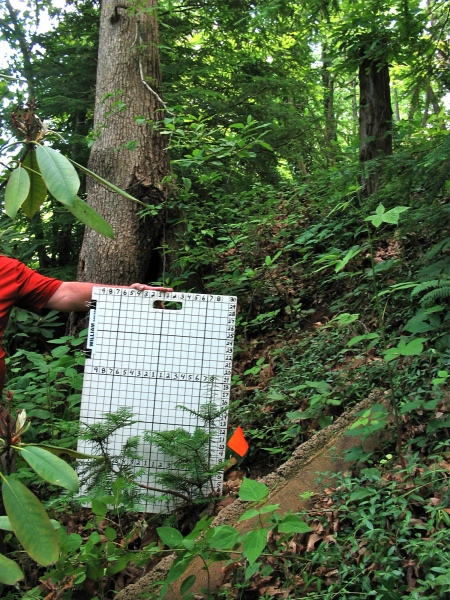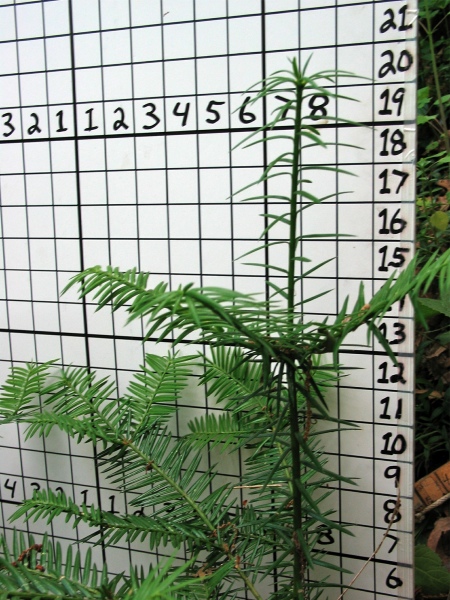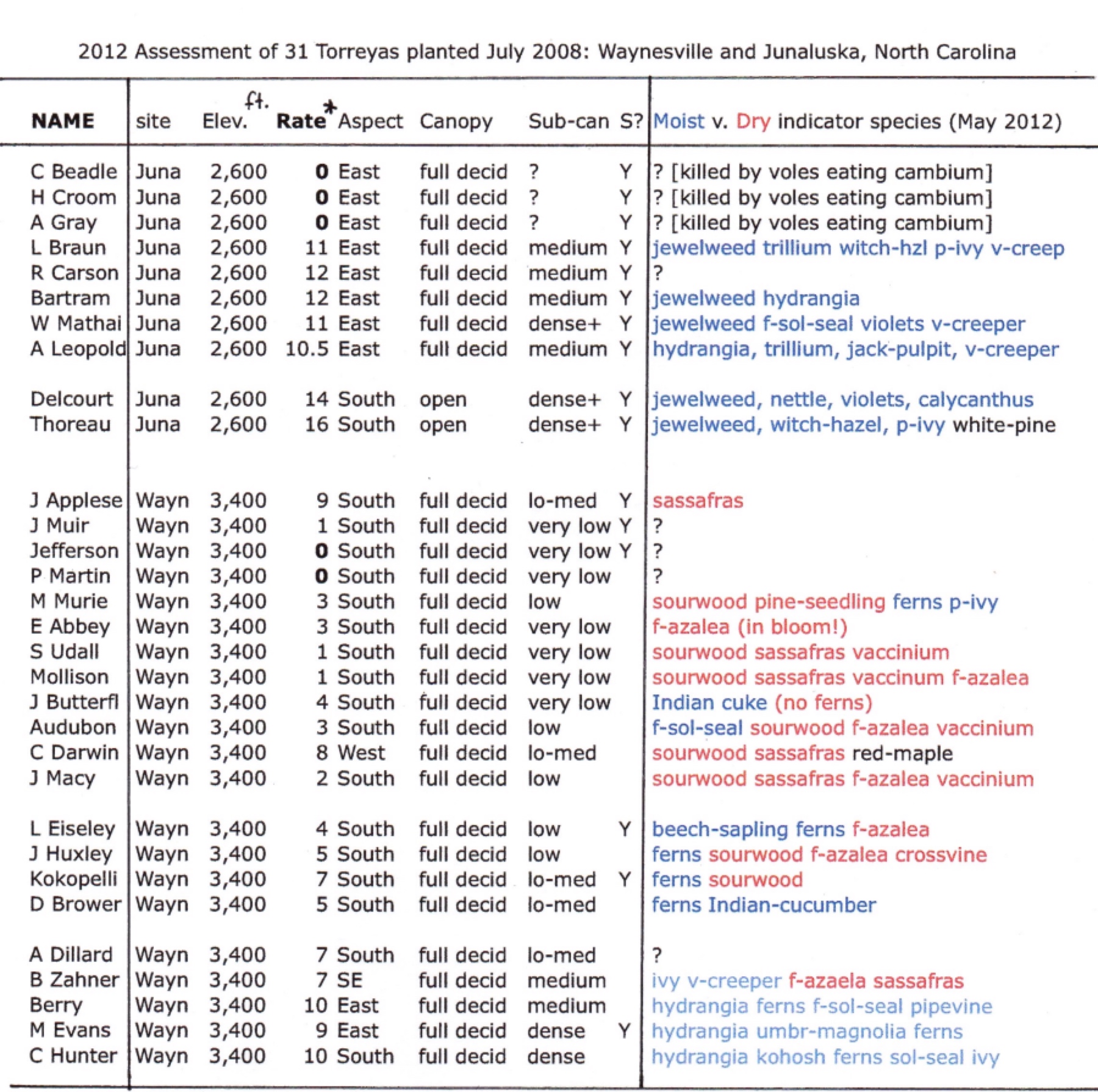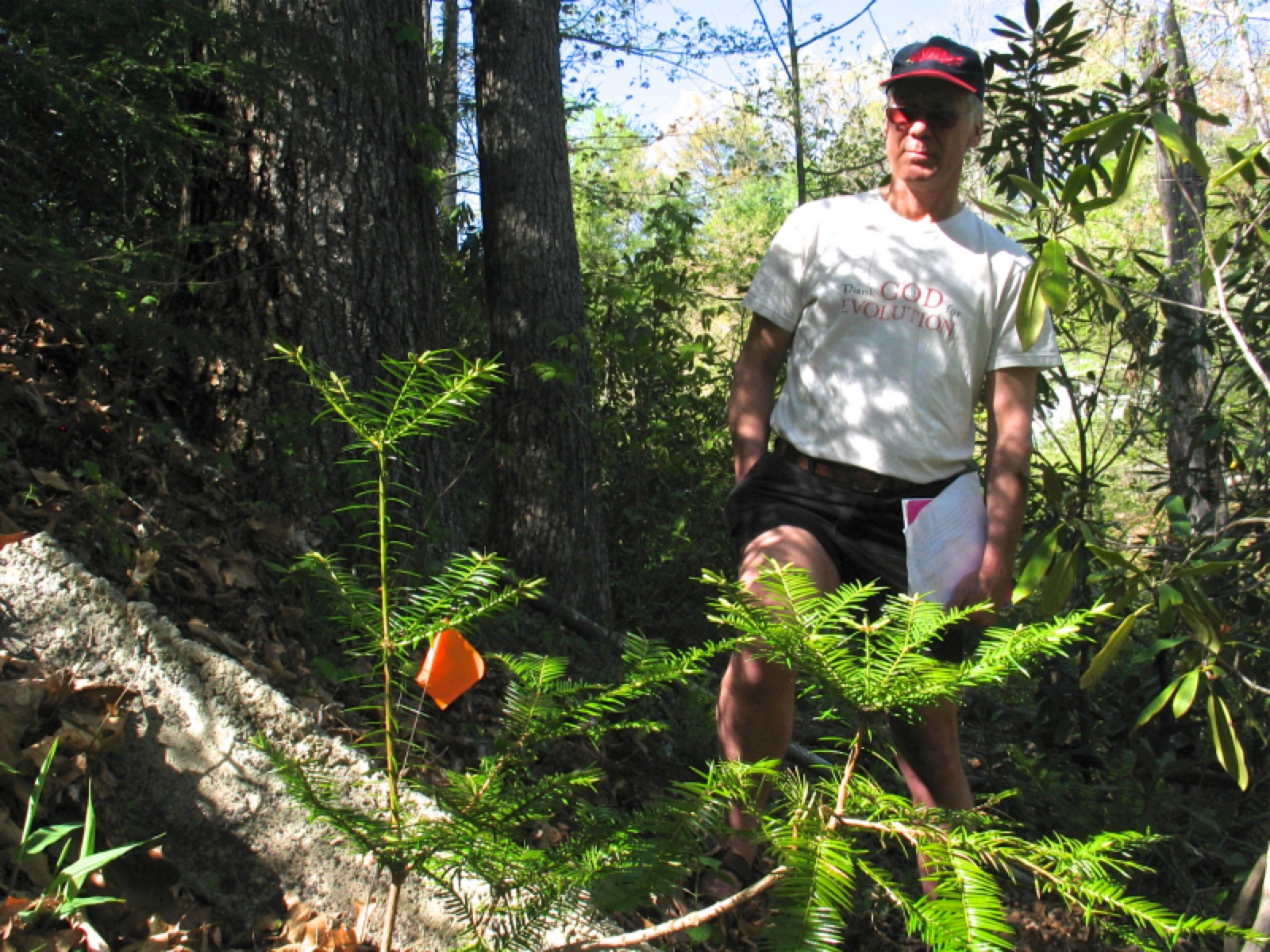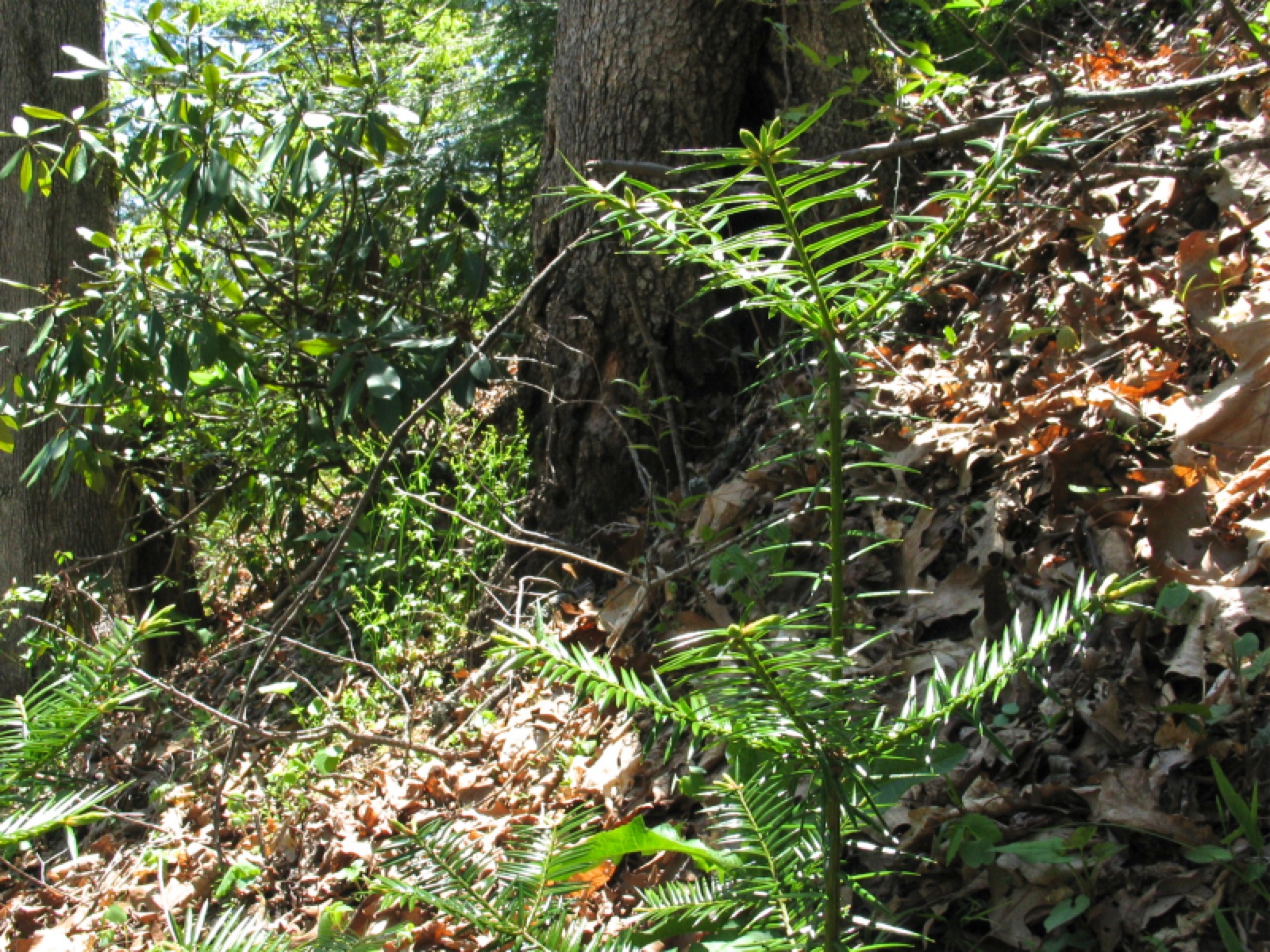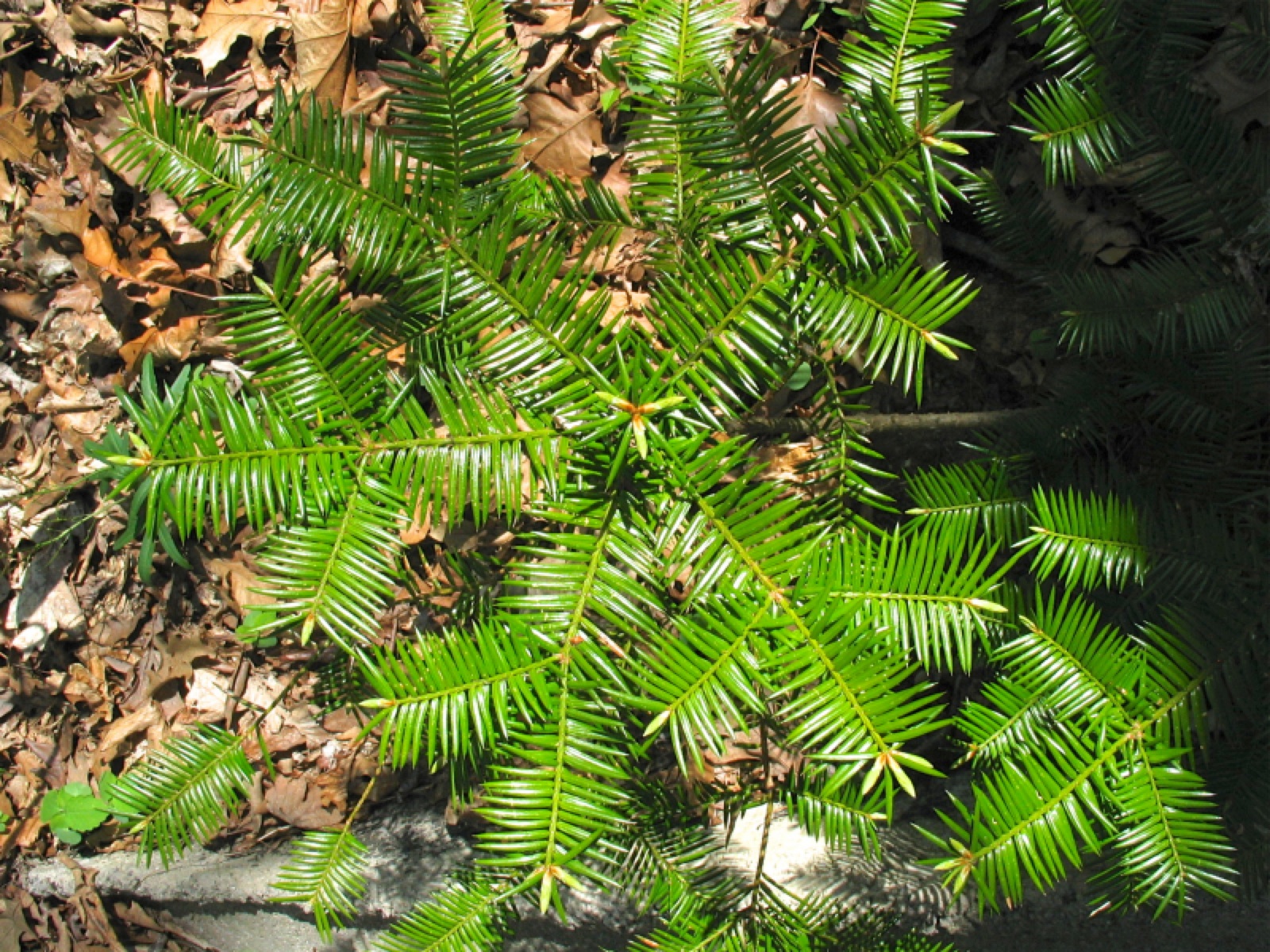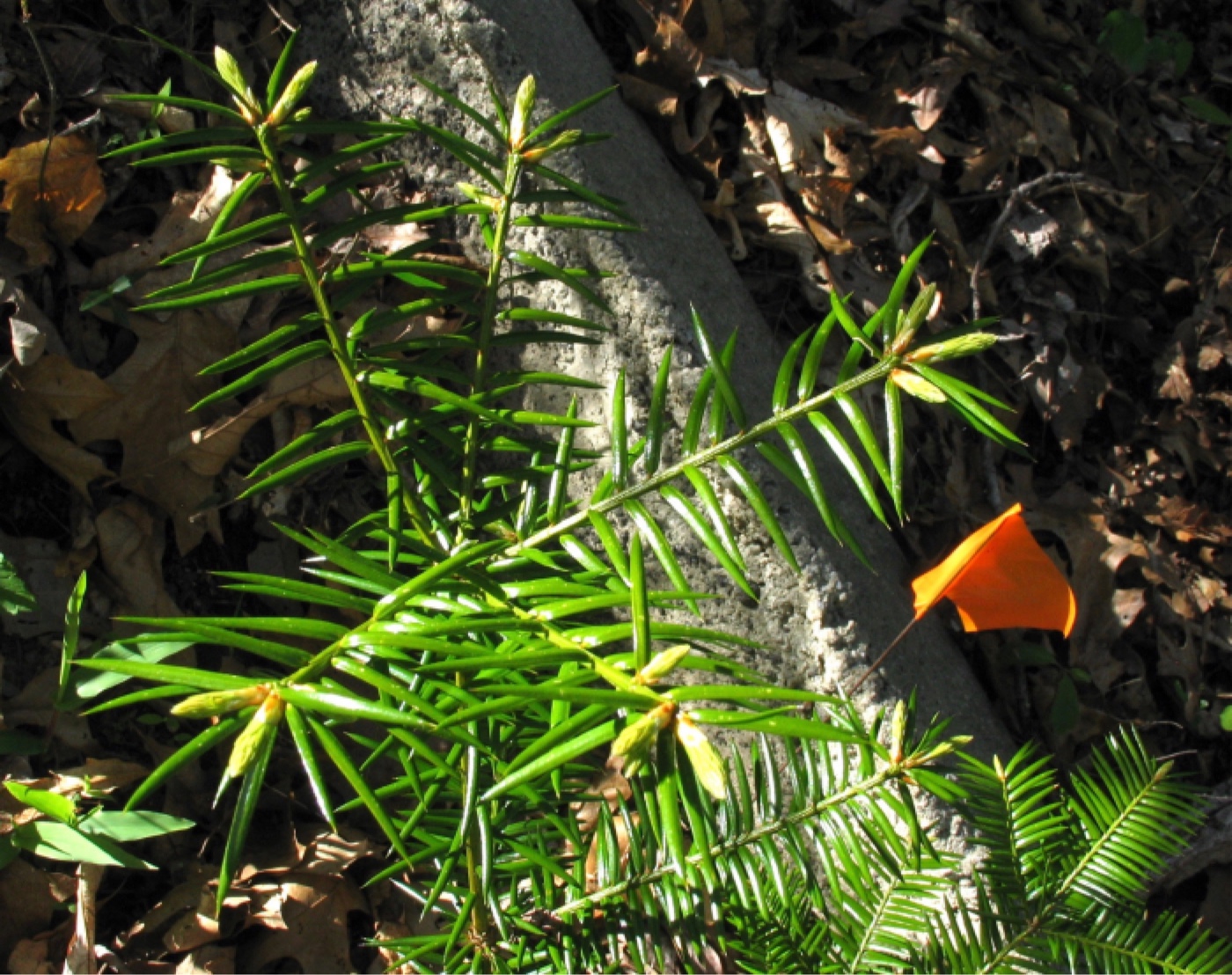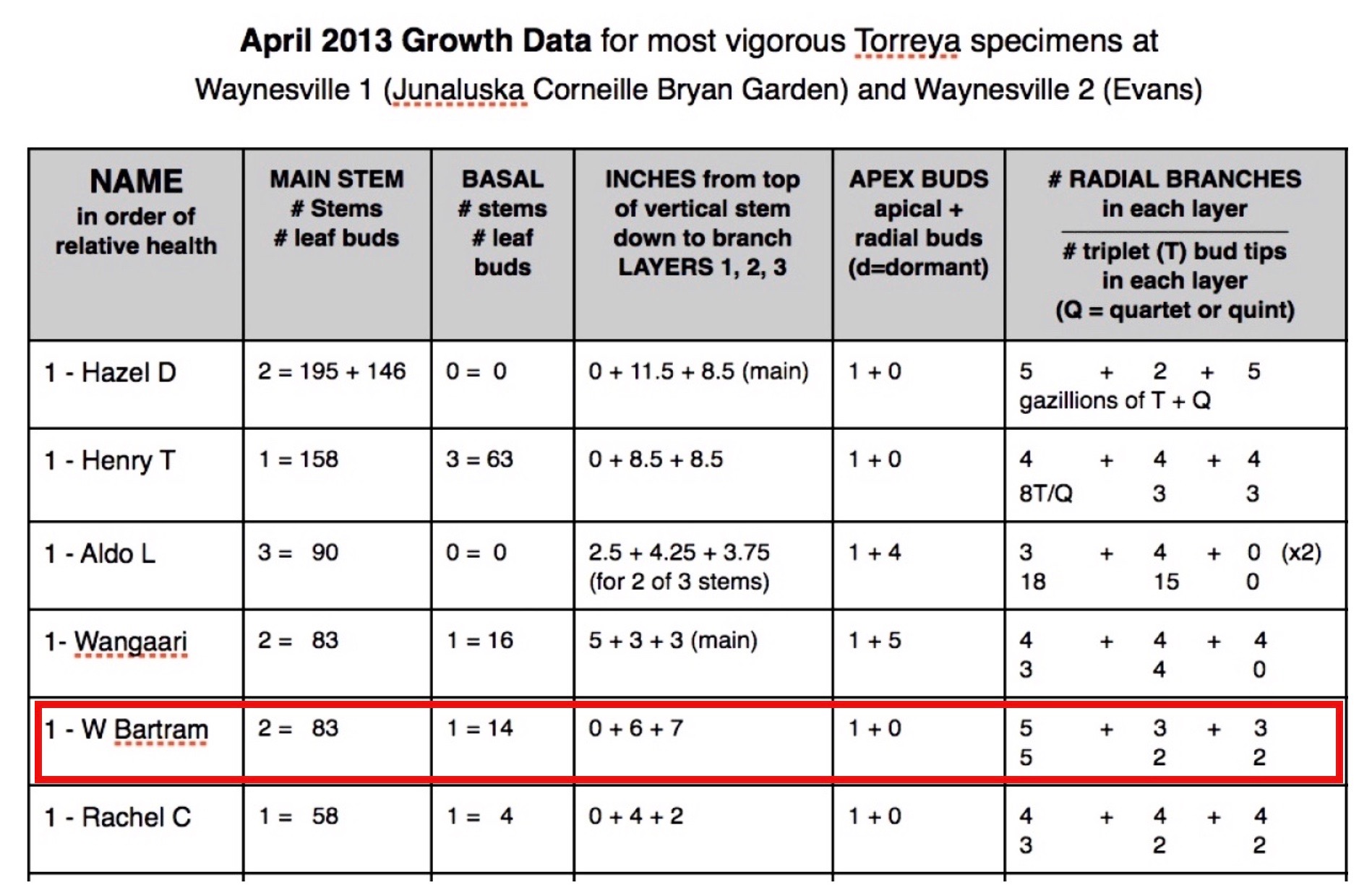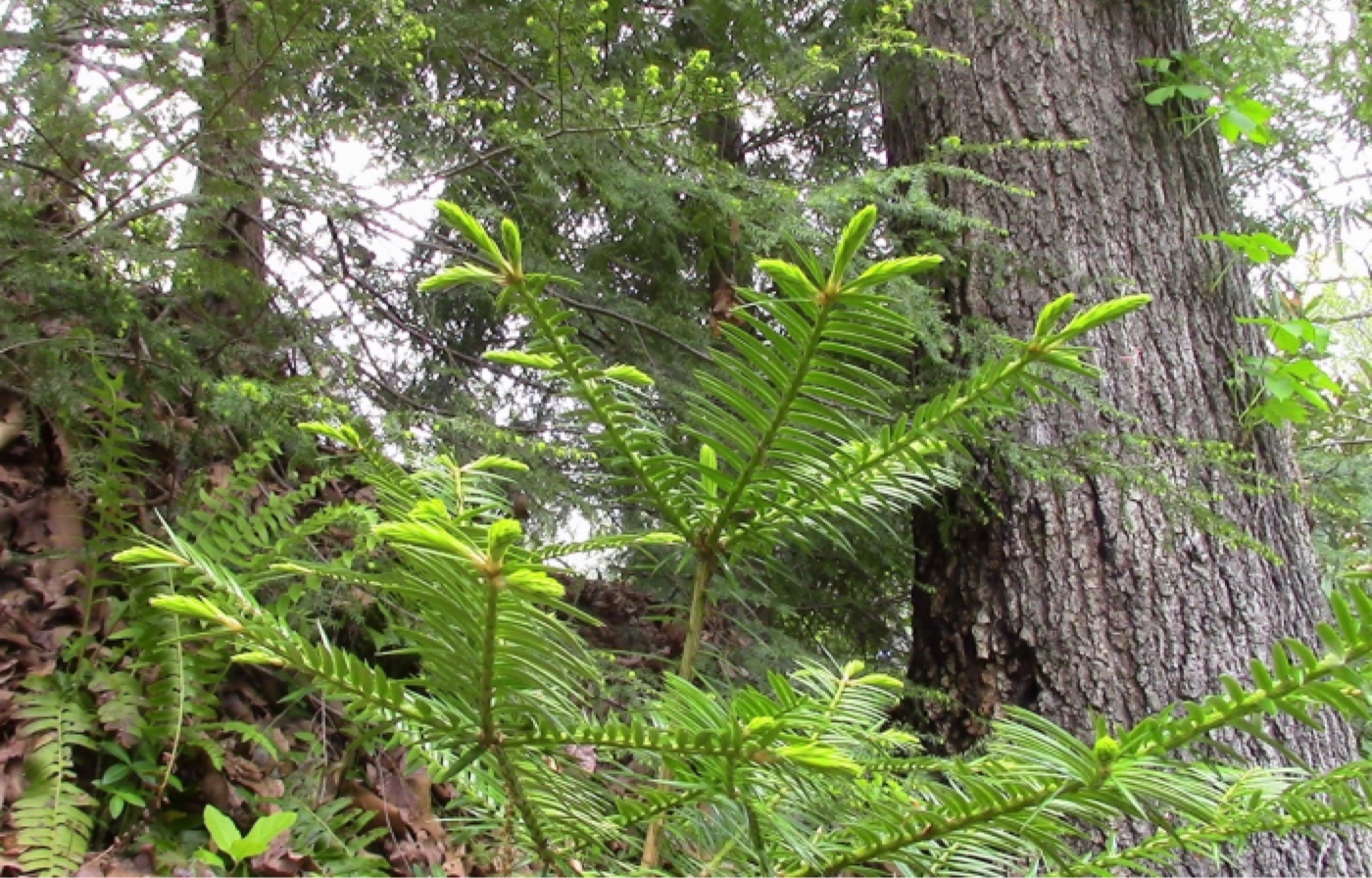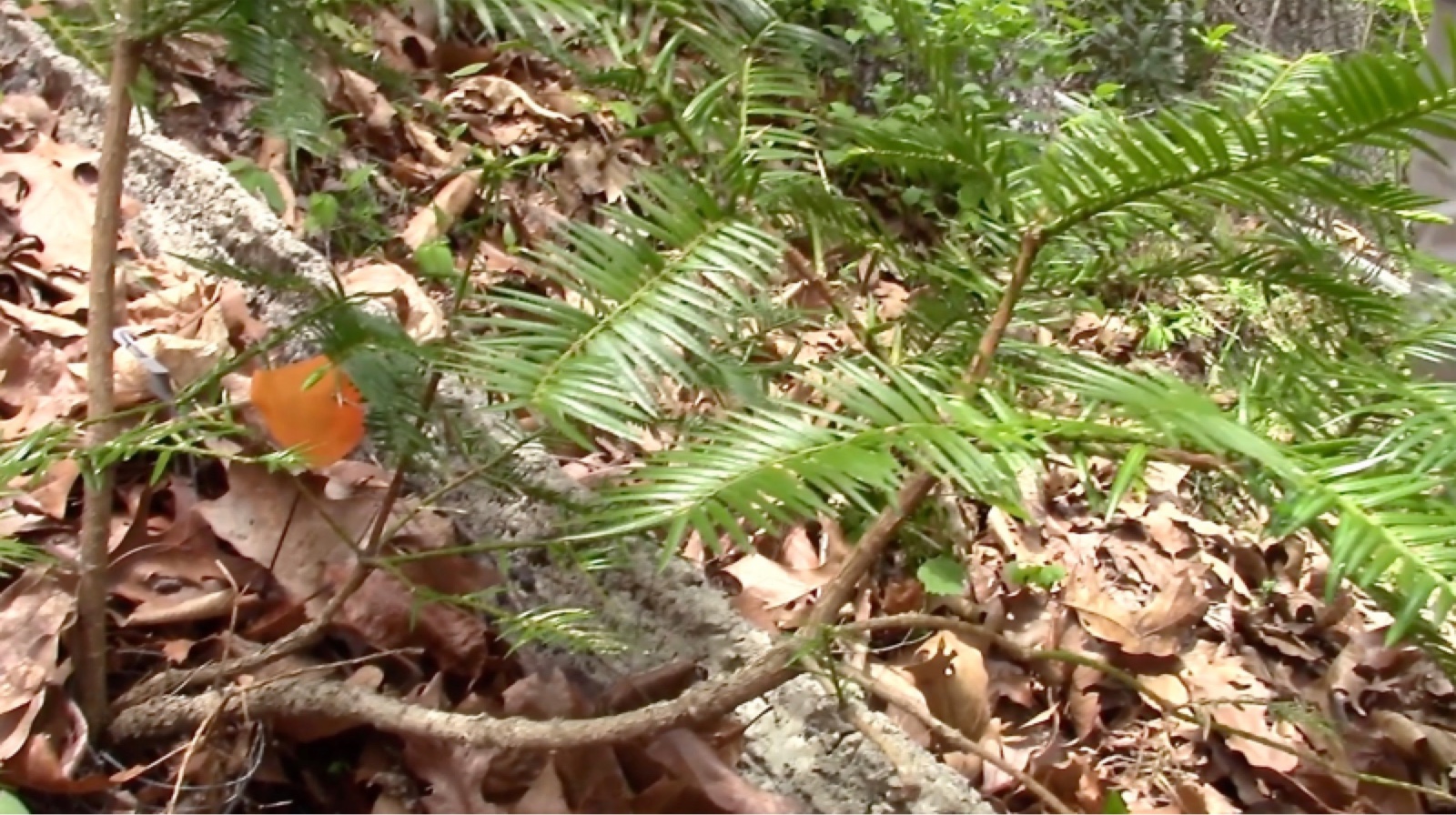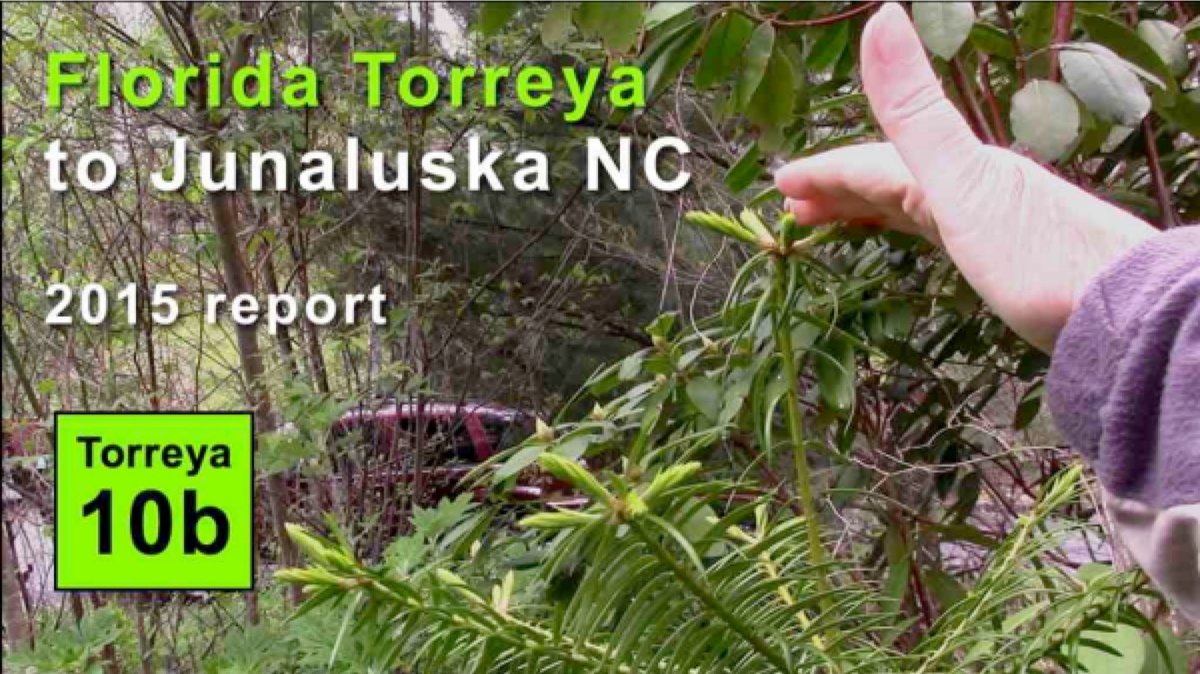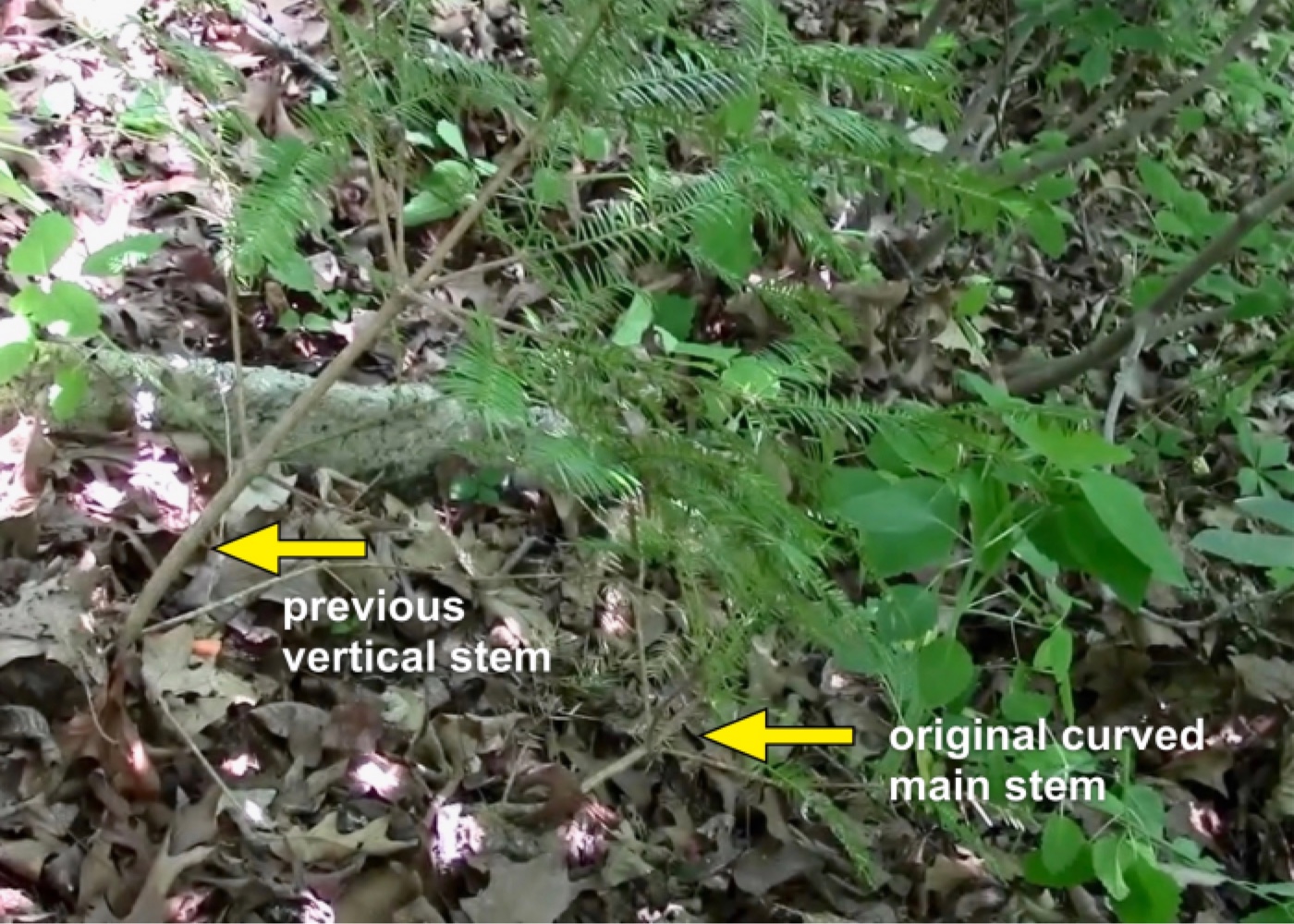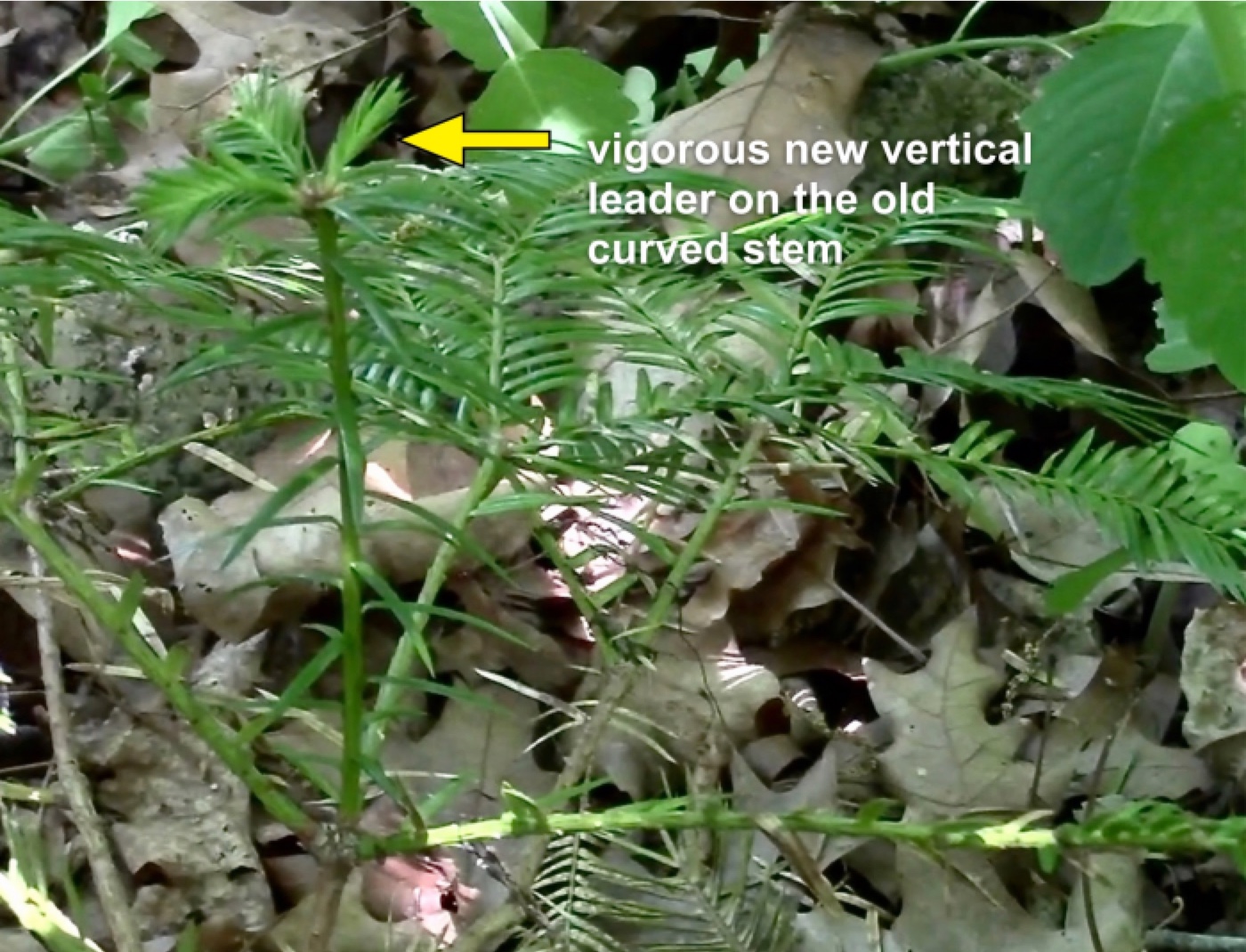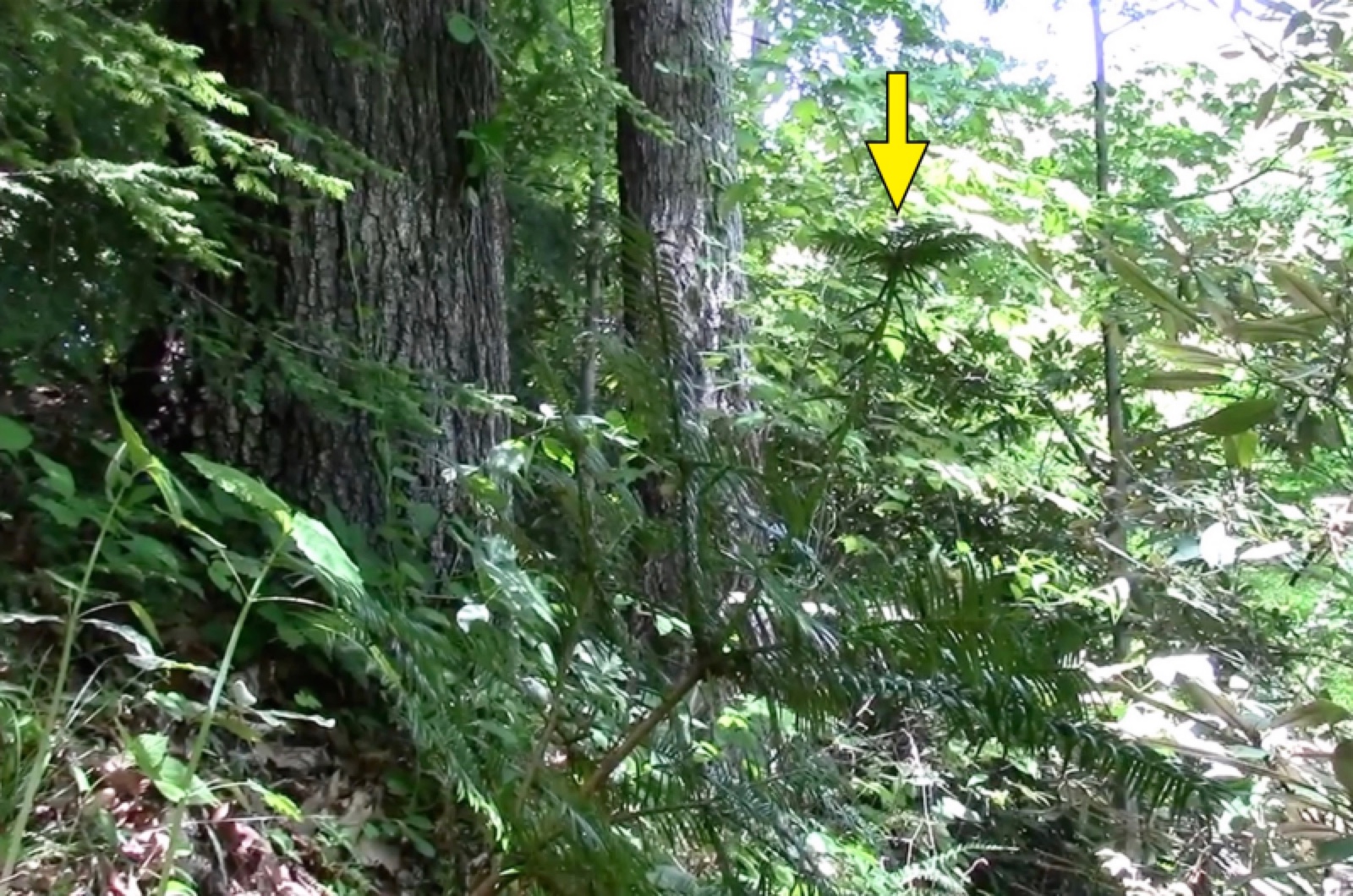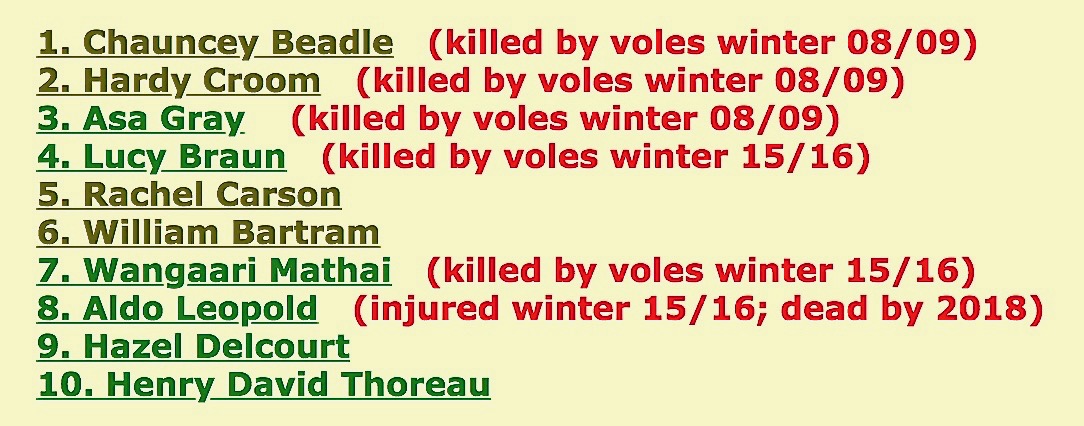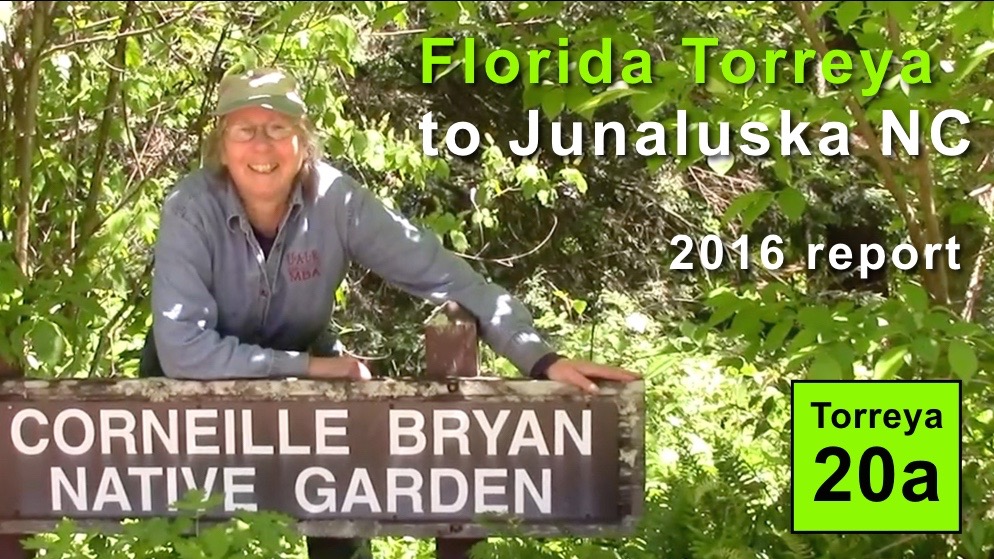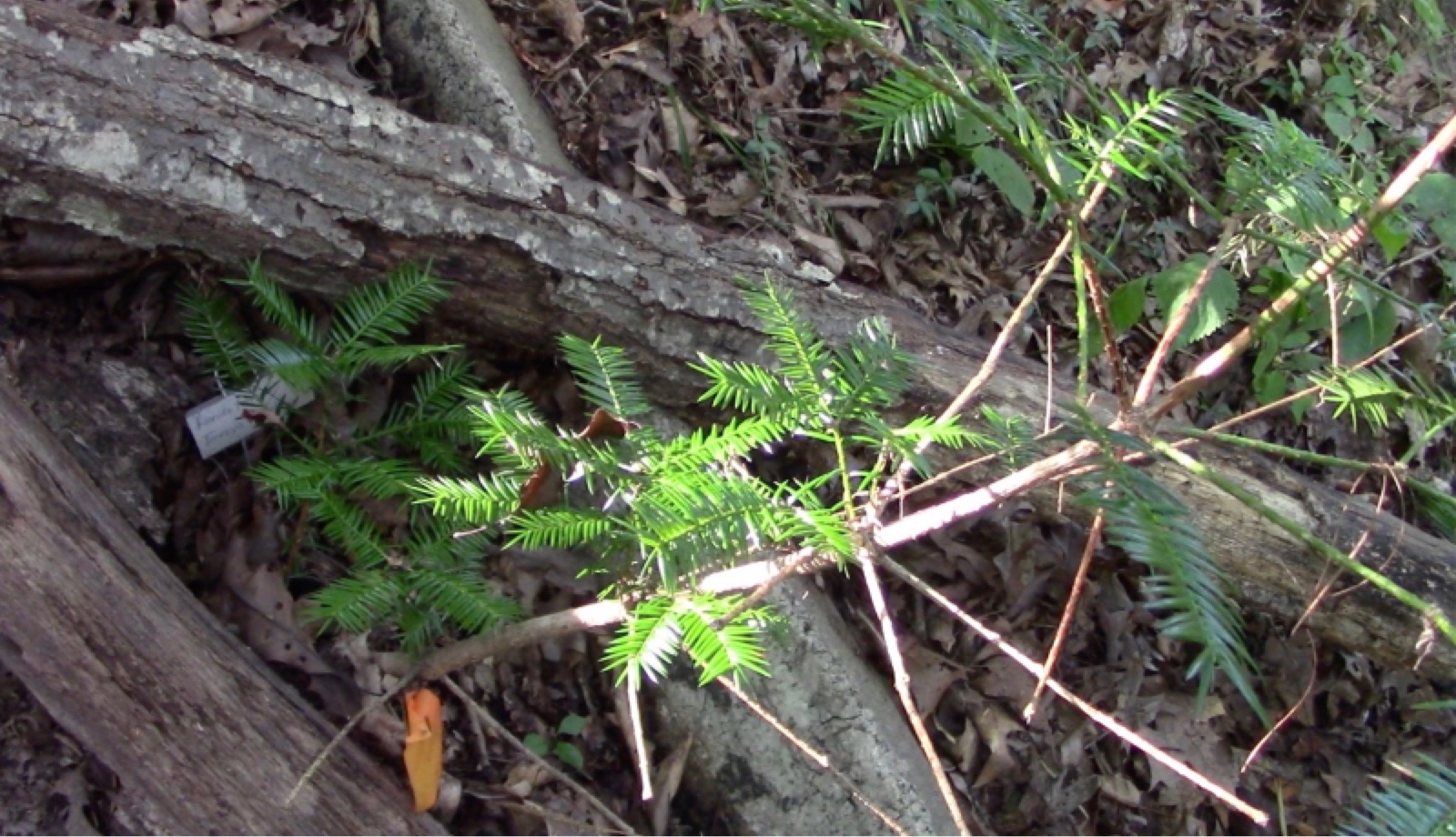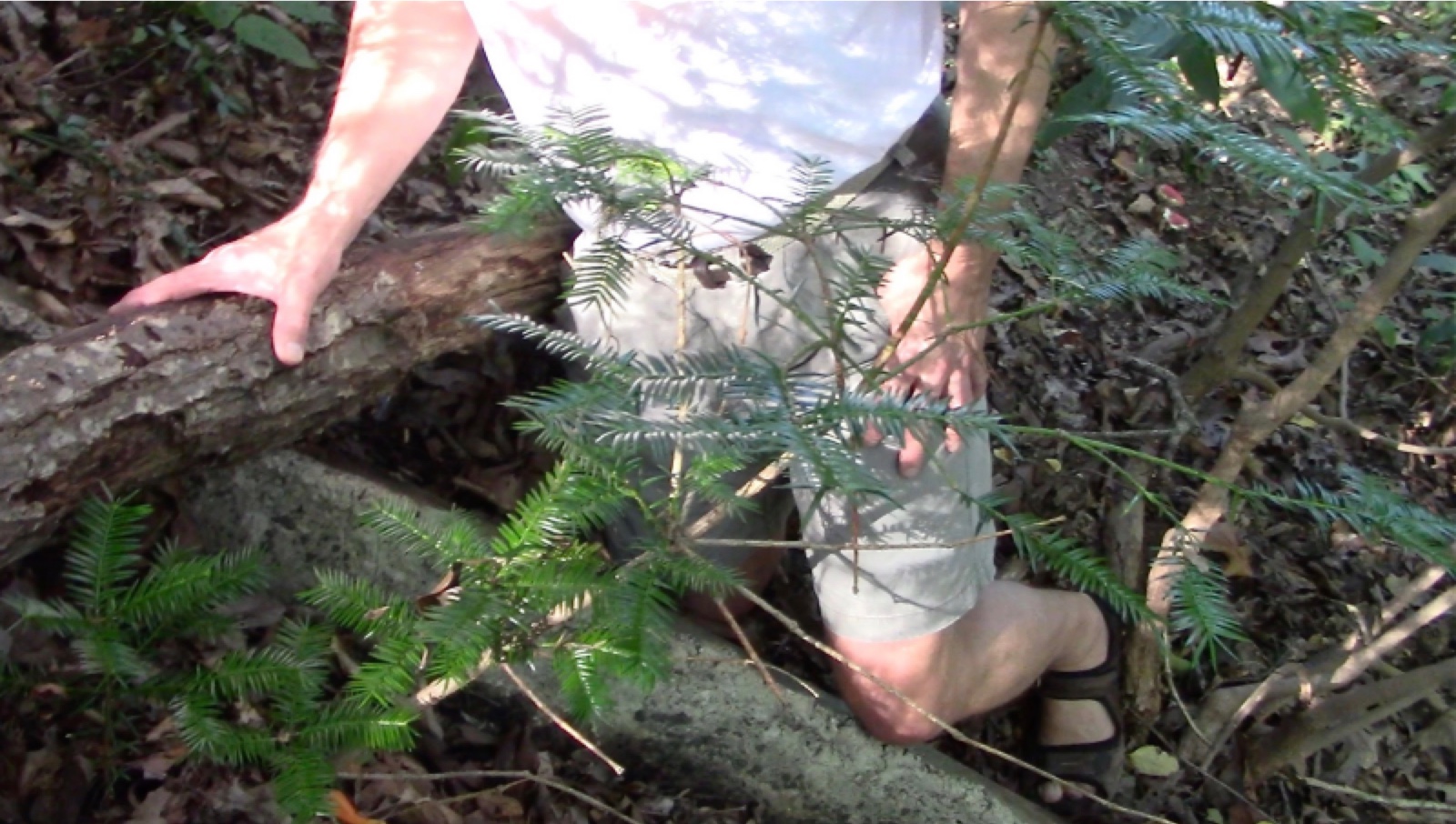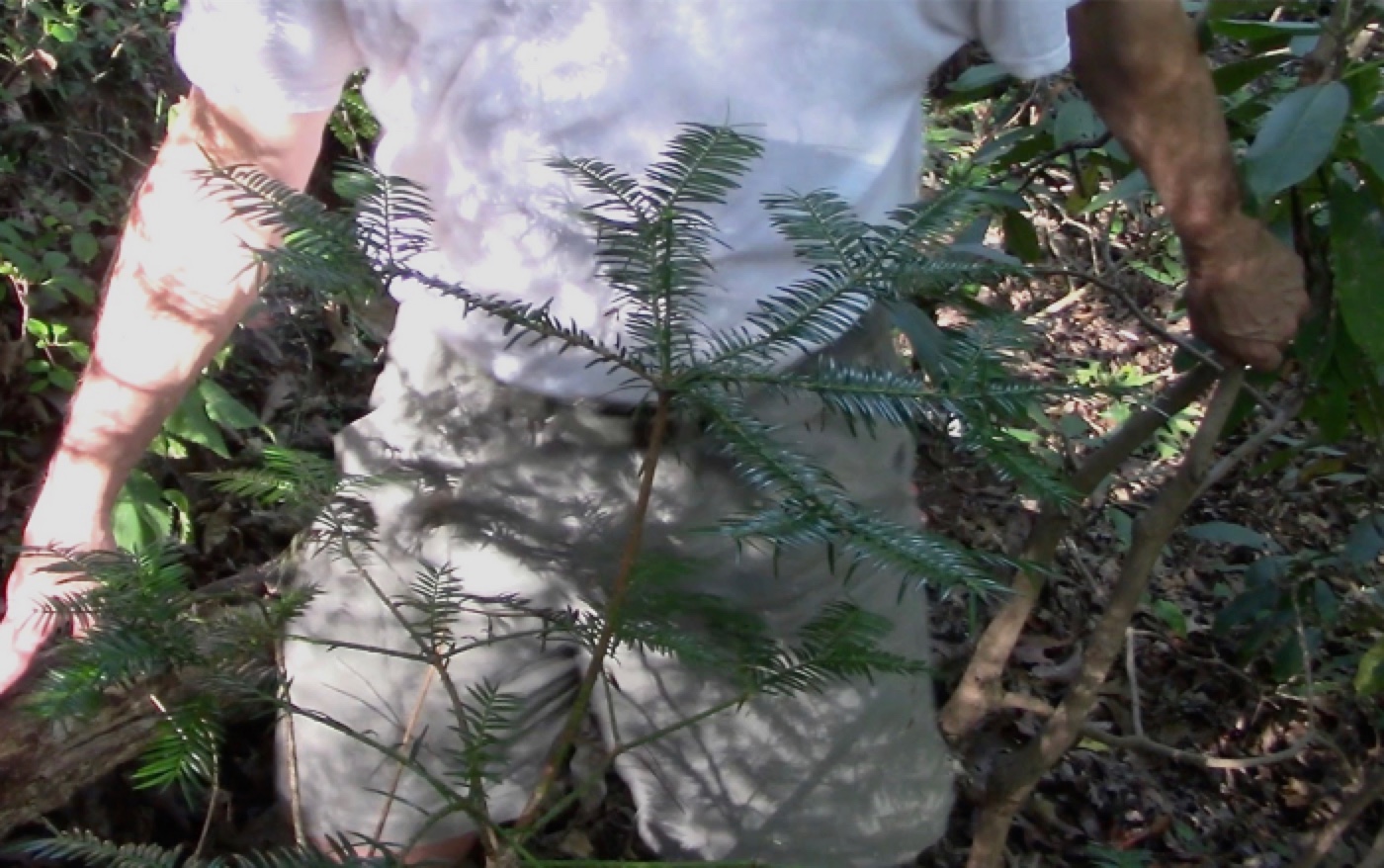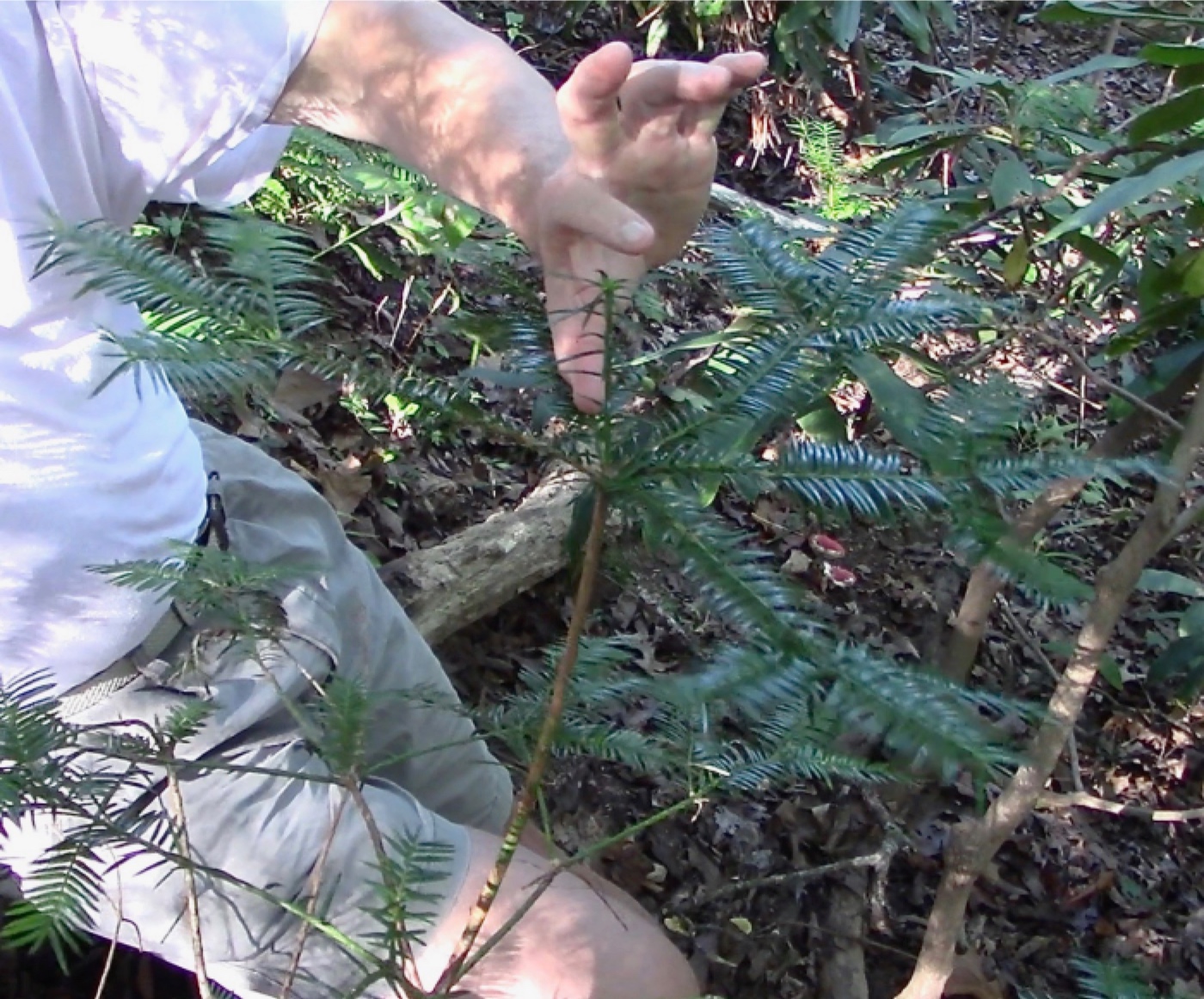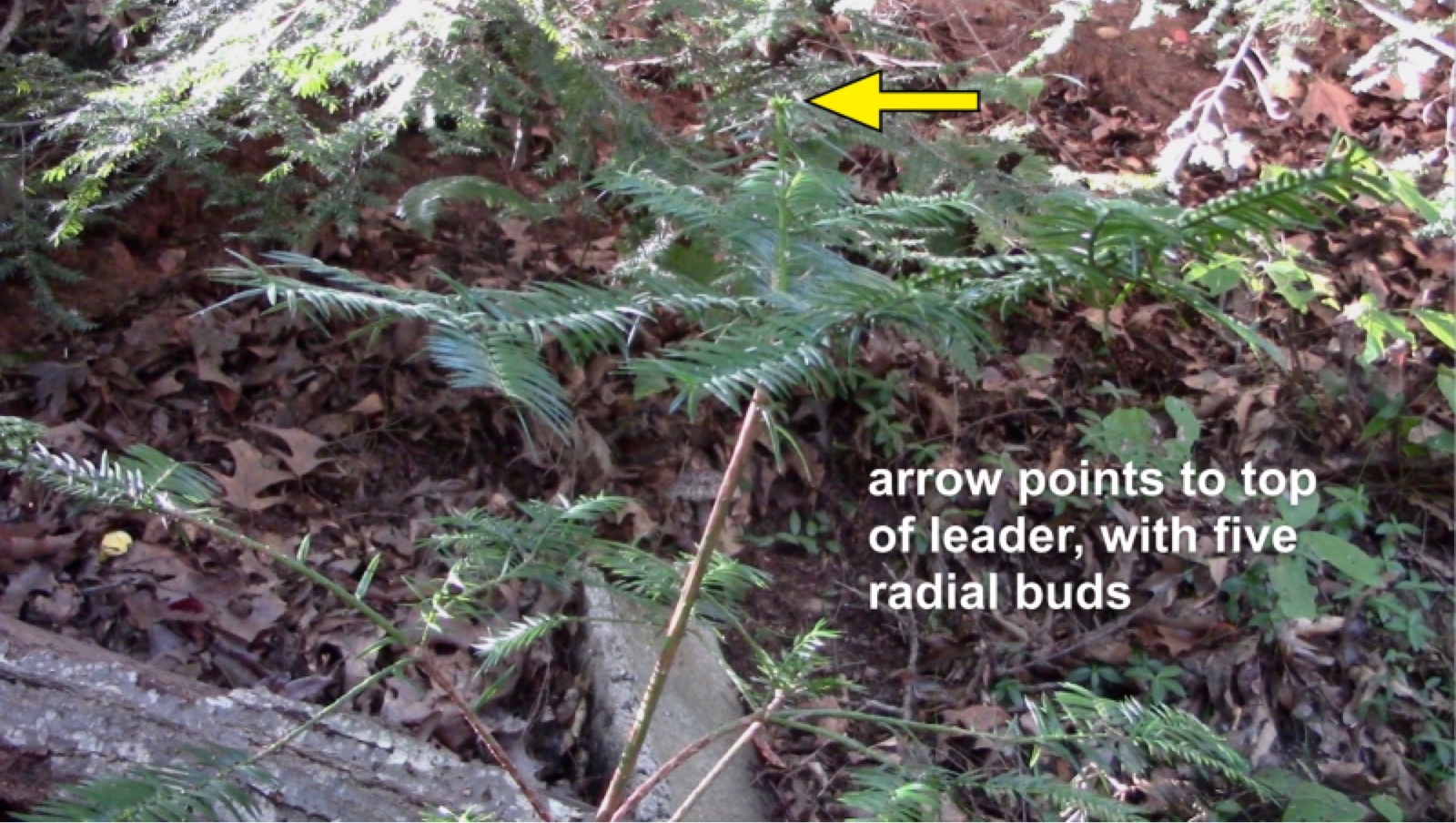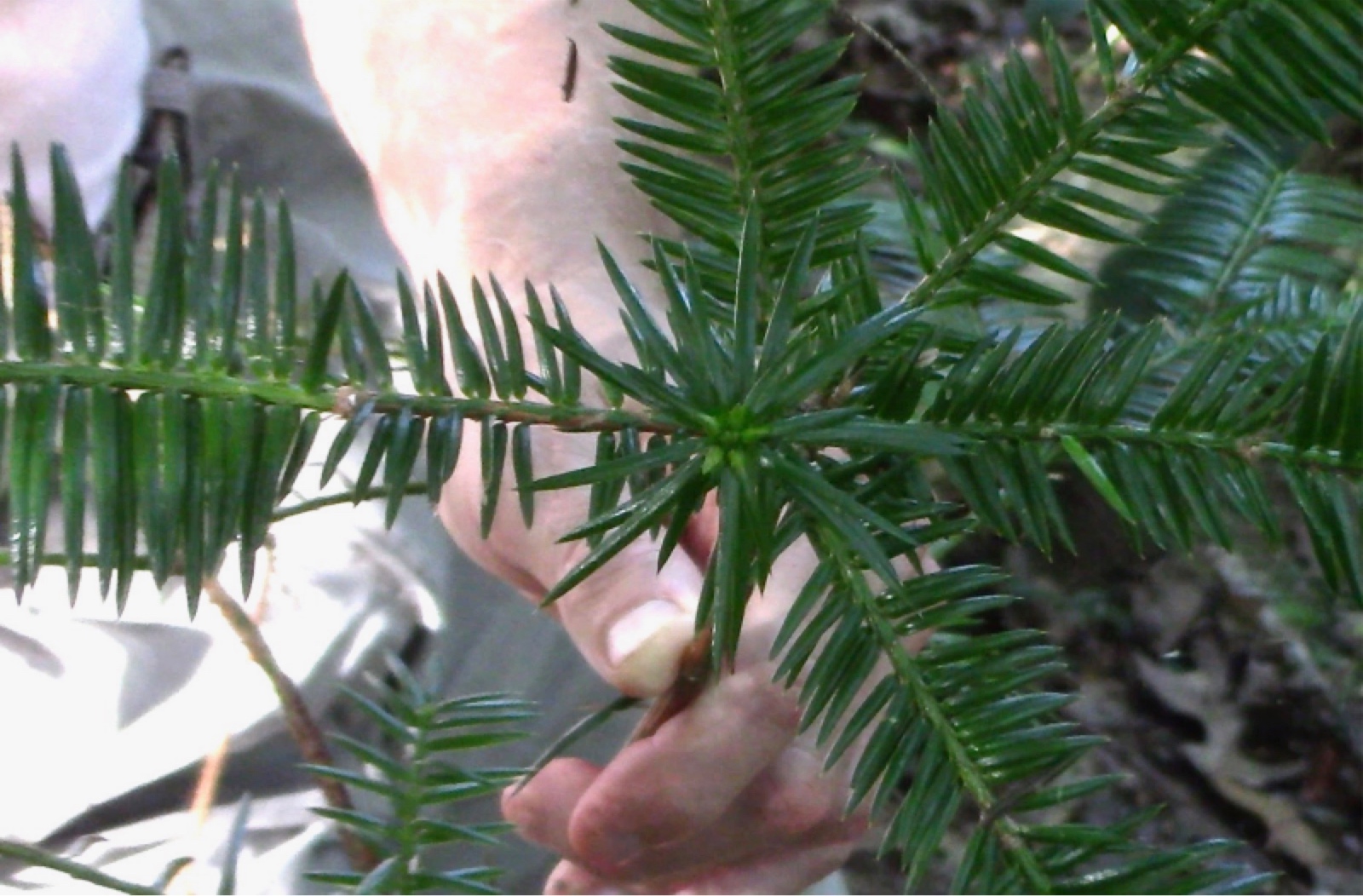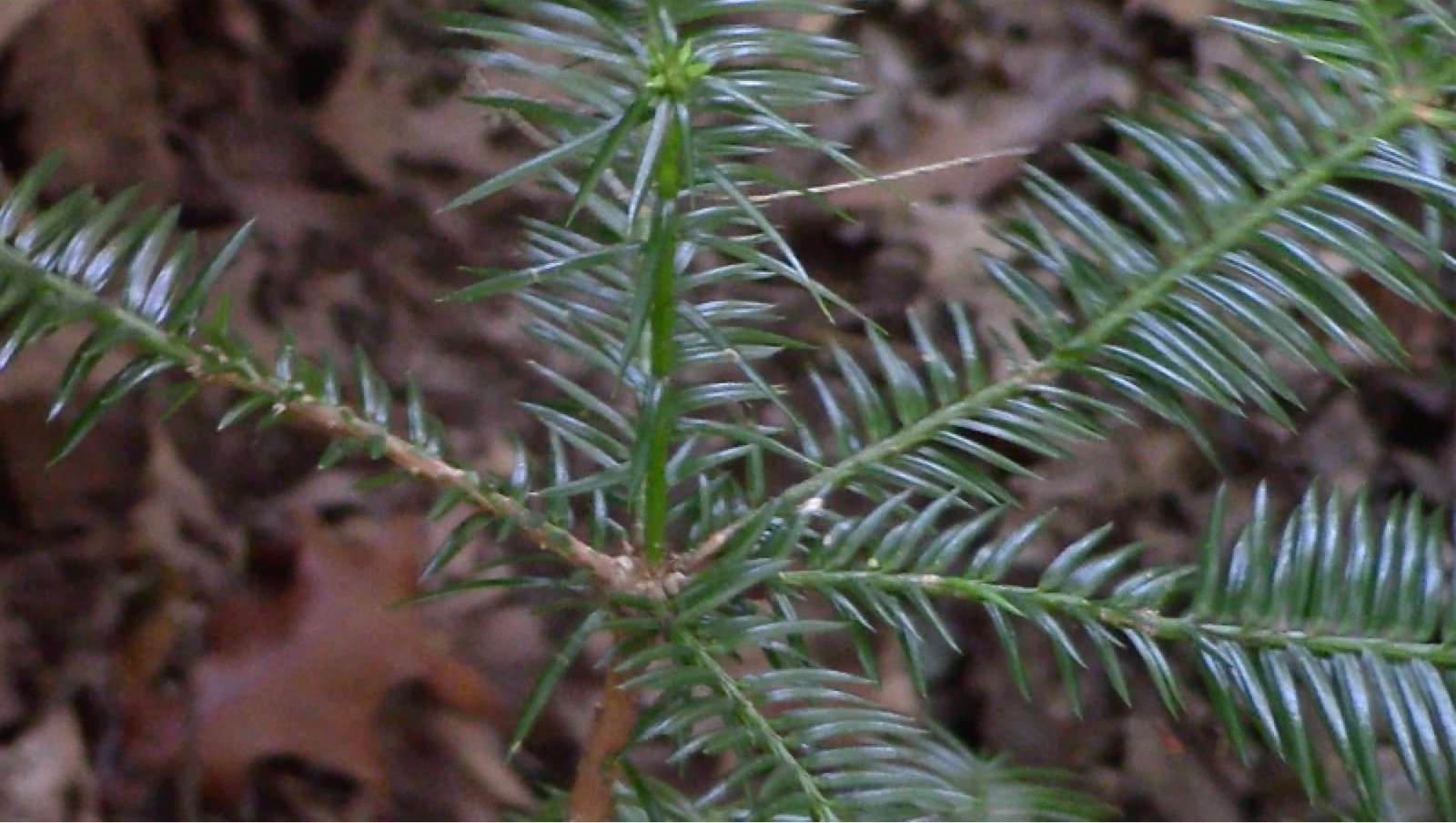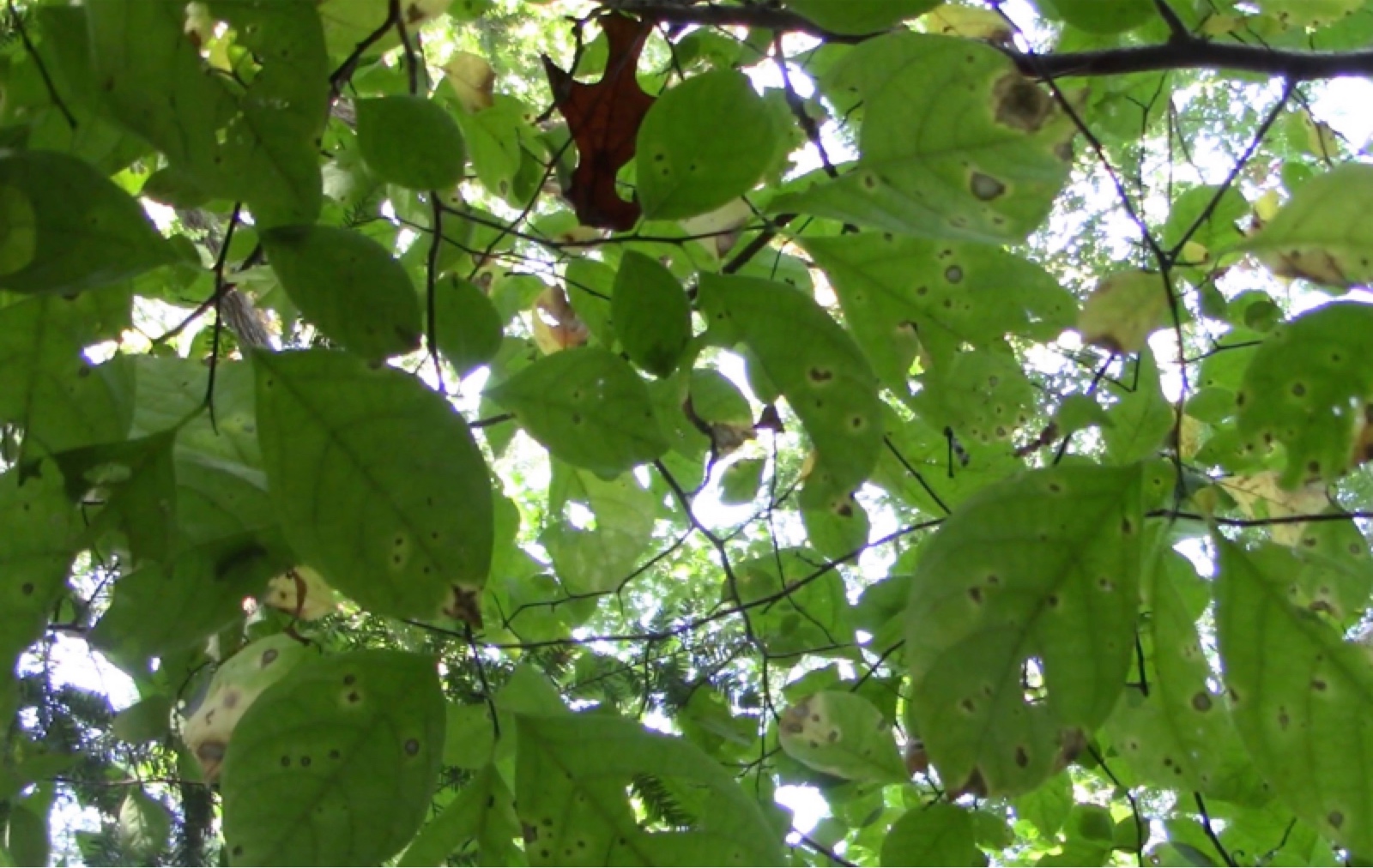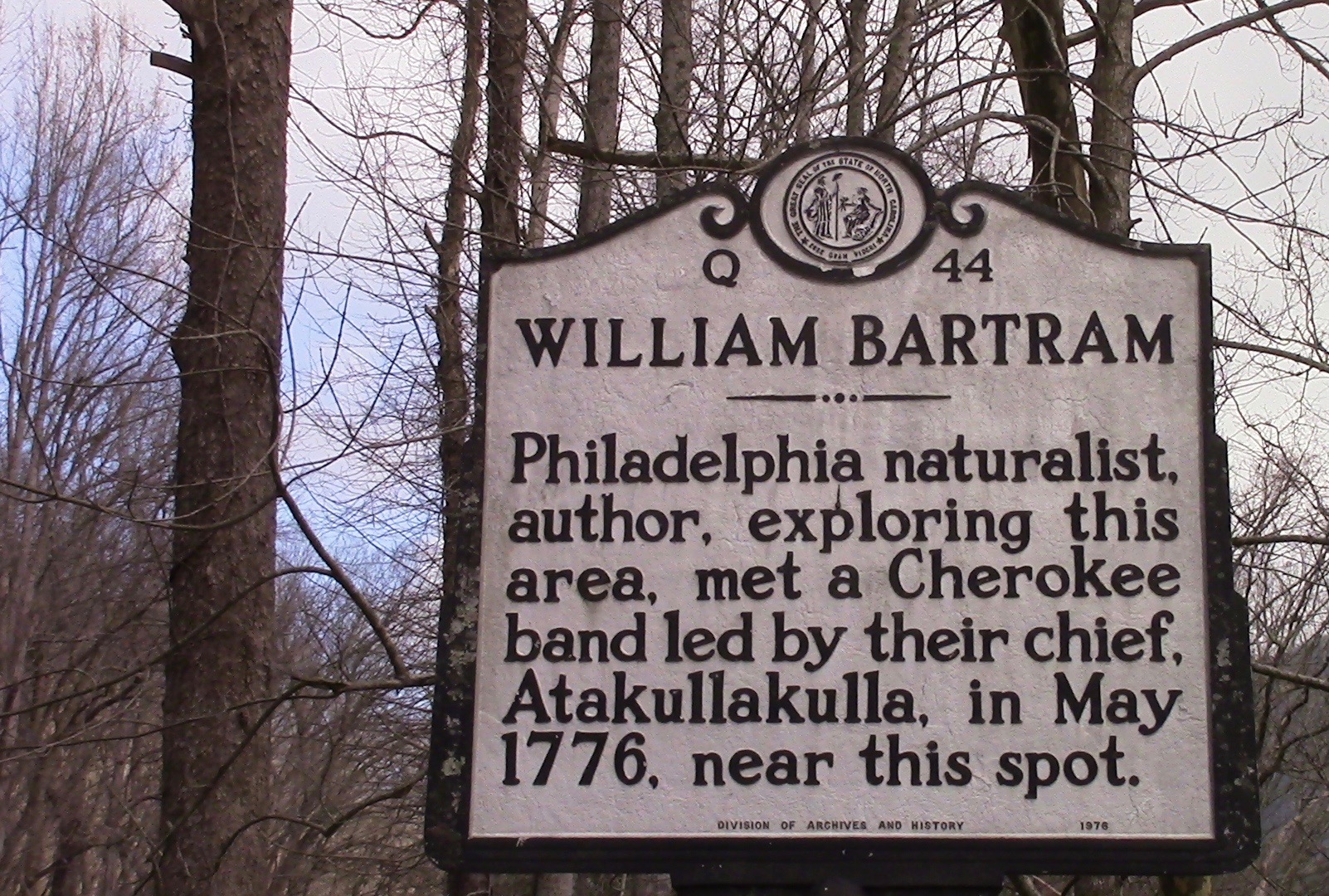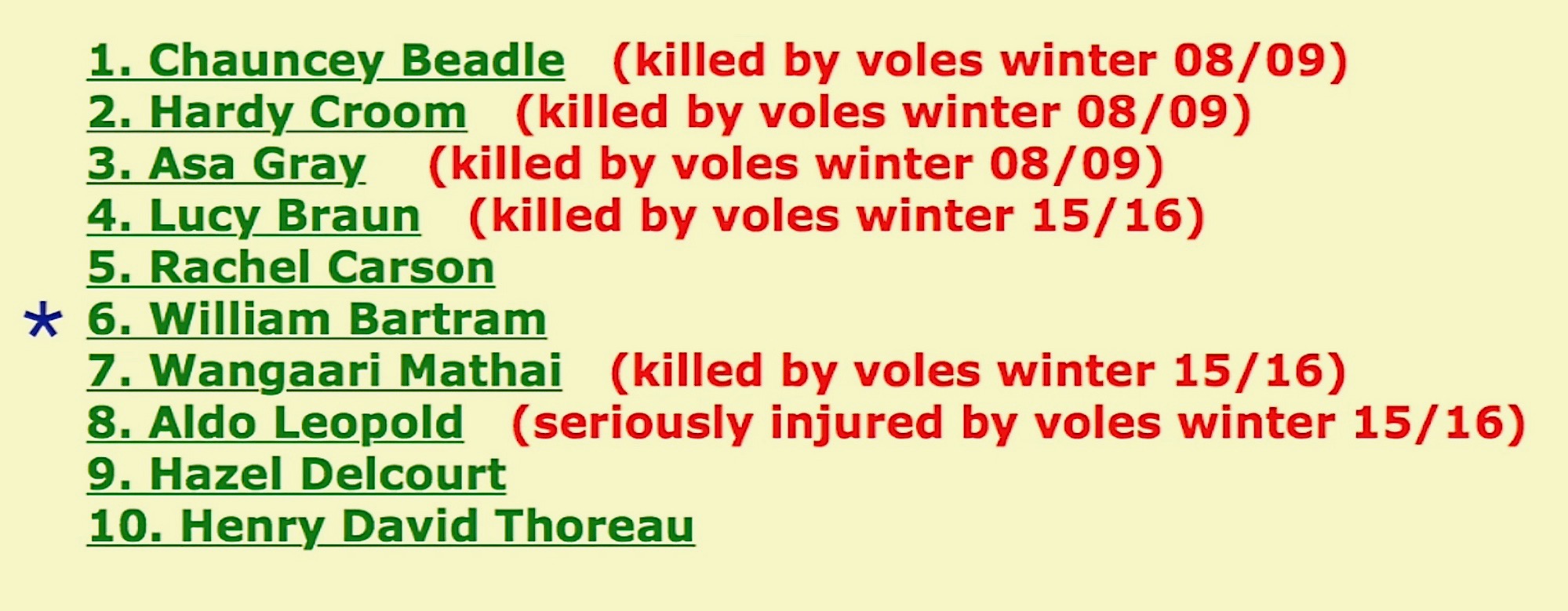Lake Junaluska, North Carolina (planted July 2008)
NE-facing slope of a NW-to-SE ravine with perennial creek at the bottom (2,600 feet elevation). The uppermost canopy is almost entirely deciduous, thus affording a lot of sun for evergreen growth in early spring, late fall, and mild winters.
ABOVE LEFT: Notice the white concrete "curb", next to the planted torreya. This is an excellent marker for finding the Bartram tree in future years, especially because the Rachel Carson tree is only about a dozen feet to its right (and slightly downhill).
Advance to TENTH ANNIVERSARY 2018 LEARNINGS here.
18 MAY 2012
ABOVE LEFT (May 18, 2012): Lee Barnes holds a grid to mark the growth and structure of William Bartram. Specimen "Rachel Carson" is visible in foreground left. Notice the Rhododendron between Rachel and William. It is an evergreen dominant in the subcanopy that can seriously block sunlight year-round. In the "learnings" section below we advise not planting Torreya anywhere near Rhododendrons.
ABOVE RIGHT AND BELOW (May 18, 2012): On a scale in which Lee rated the "Celia Hunter" specimen at Waynesville a 10 the previous day (May 17), William Bartram is rated a 12. There are now two main stems on this specimen, both of which show healthy apical growth. (The right-side stem's leader is difficult to see above right, because it is positioned just to the right of the grid; so look carefully there. It is easy to see in both images below.)
ABOVE CHART: In 2012, Lee Barnes accompanied Connie Barlow on an assessment of all of the 2008 plantings on both the Junaluska and Waynesville sites. Connie asked Lee to use his judgment in rating each of the trees. Because they visited the Waynesville site first, two trees tied there for the highest rating on a scale of 0 to 10 (Thomas Berry and Celia Hunter). When they visited Junaluska, however, the torreyas were so much more vibrant that the scale began at 10.5 and went up to 16 for Henry David Thoreau. WILLIAM BARTRAM was rated 12.
Spring 2013 photos below taken April 23, but spring was delayed nearly 2 weeks, so it is more like April 10. Thus, instead of light-green new growth photographed above in 8 May 2012, there are only light-green leaf buds to indicate the vigor of the plant.
ABOVE LEFT (April 23, 2013): There are two main stems on the William Bartram Tree: a vertical stem just left of the flag, and a downhill curving stem with similar radial top-growth. This is an ideal growth pattern for a subcanopy young tree. Notice how the growth pattern shifted remarkably from the potted growth form in 2008.
ABOVE RIGHT (April 23, 2013): Closer look at the vertical stem: notice the upper tier of radial growth is separated by 6 inches from the next layer down of radial growth. Compare this photo to the 2012 photo directly above it. See that 2012 produced not only the 6 inches of spring vertical stem, but all the top radial growth as the summer proceeded. Even in northern states, Michigan and Ohio, we are finding that Torreyas tend to produce two spurts of above-ground growth if healthy: the first in the spring and the second August through September. In western North Carolina Connie has seen instances of new growth still soft and underway in late October and early November — so in the southern Appalachians a warm autumn might bring forth a third growth spurt.
ABOVE LEFT (April 23, 2013): Top-down view of the downhill-curving original main stem. This apex of the leader has 3 light-green leaf buds poised to make another whorl of lateral branches. The previous whorl shows 5 lateral branchlets — rich in new buds at the tips. This year, as usual for horizontally maximizing growth, the middle branchlet at the ends of each branch bears 3 leaf buds (a triplet), while each of the side growths bears a single leaf bud.
ABOVE RIGHT (April 23, 2013): View from above of the top of the vertical stem (directly above that is a side-view of the same stem). The concrete curb remnant provides orientation.
NEW MEASURE OF HEALTH IN 2013: leaf bud count = 83 on the two main stems combined and 14 on the single ancillary basal stem. See chart below:
ABOVE LEFT (April 25, 2015): This is the top of the straight and tall stem of the two-stemmed William Bartram Tree. It is backed by a Red Oak. In the left background are evergreen small hemlock trees. (In 2018 several of the hemlocks will have died and fallen in close proximity to William.) ABOVE RIGHT (April 25, 2015): As of 2012, the Bartram Tree clearly had two main stems: one curving and the other vertical. Although this curving (original) stem is thicker at the base than the vertical stem, the vertical stem has been taller ever since the growth spurt of spring 2012.
ABOVE: Two big changes this year: (1) two dead hemlock trunks fell down onsite, and (2) the original curved stem went missing. Now, there is only one long, leaning stem — plus a new basal (by the rectangular aluminum label). Notice that the long stem curves right up along Michael's arm. The uppermost fallen log rests on the concrete curb remnant.
ABOVE: The single remaining, angled stem has a top whorl of 5 radiating branches. All five put on triplets of new growth at the tips this year's past growing season. Michael Dowd shows that a new vertical leader also grew this year: about 3.5 inches.
ABOVE: Match the long brown stem growth spurt (left) to a 2016 photograph above that shows the same segment green. Michael orients the top of the stem toward the camera: 5 radial buds will produce a new whorl of top branches next spring. (See also below left.)
ABOVE RIGHT: A subcanopy deciduous shrub directly above William obscures the Red Oak leaves still shading the upper canopy in early October. However, now that some of the upslope hemlocks are gone, will William Bartram be able to capture more winter sun?
• WILLIAM BARTRAM is well-known to naturalists in western North Carolina.
The Lake Junaluska locale offers insights for helping species recovery ...
1. ASSISTED MIGRATION - The plants seem to be disease-free at this latitude and elevation some 300 miles north of the historically native range in Florida.
2. ADAPTIVE GROWTH FORMS - If afforded the opportunity to grow in open sunlight, Torreya takes the form of a standard conifer (HAZEL DELCOURT and HENRY DAVID THOREAU). If the habitat is shaded subcanopy, its form is yew-like and growth is much slower (RACHEL CARSON and WILLIAM BARTRAM). Because Torreya genus is not a pioneer-sere taxon, only human intervention in cutting back overgrowth shade can maximize Torreya's growth potential and induce an upright form (and early seed production). As of 2018, no reproductive structures have been observed on even the tallest individuals (HAZEL DELCOURT and HENRY DAVID THOREAU).
3. ROOT-EATING RODENTS - Of the original 10 plantings in 2008, only 4 remain in 2018. All 6 deaths are attributable to tunneling, root-eating rodents. Because the same-age, same genetics Torreya planting at the Waynesville site has not been afflicted in the same way, the rodent problem must be site-specific. The forest garden (Corneille Bryan) is surrounded by pavement and homes, and there are two sources of boom-and-bust foods: (a) the Red and White Oaks have multi-year cycles of acorn masting, and (b) the house in the southwest corner of the garden forest has a birdfeeder overhanging its deck that drops seed only during this seasonally occupied summer community.
4. COMPETITIVE EXCLUSION BY RHODODENDRONS - Rhododendrons and Mountain Laurels are evergreen, subcanopy shrubs. Rhodies easily outpace Torreyas. (RACHEL and WILLIAM both have rhodies encroaching.)
5. REWILDING CONSTRAINTS - Unlike animals, plants cannot move to situate themselves in ideal circumstances — so we planters must attempt to find those macro sites (latitude, elevation, slope, aspect, forest type) and micro sites: rhododendron-free, deciduous canopy, extreme slopes. Until hundreds of seeds or seedlings are available for outplanting in each area, human interventions will remain necessary for ensuring speedy development of reproductive populations.
MAIN PAGE OF TORREYA REWILDING PHOTOESSAY |
